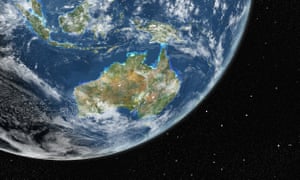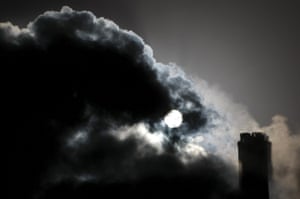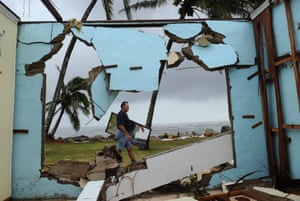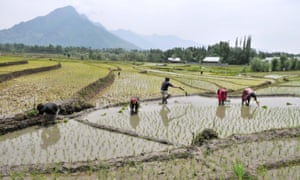Bushfires, heatwaves and early deaths: the climate is changing before our eyes
In an exclusive extract from his new book, Atmosphere of Hope, Tim Flannery argues that recent events in Australia and around the world show how global warming is much more than a debate about scientific projections

Globe Centred On Asia And Oceania, True Colour Satellite Image Photograph: Planet Observer/Getty Images/Universal Images Group
When I wrote The Weather Makers, I laid out the state of climate science as it was understood in 2005. The book received much acclaim, but it was also criticised by climate-change sceptics as extremist and alarmist.
Since the book was published, the Intergovernmental Panel on Climate Change (IPCC) has completed two major summaries, in the form of its fourth and fifth assessment reports, and thousands of scientific publications have added to our understanding of how Earth’s climate system responds to carbon pollution.
As a result, many details of climate science have been clarified. Not only are the scientific projections of major trends more certain than ever, but today many of us also have firsthand experience of living in a strongly shifted climate. With climate change an experienced reality, and the science verified, the room for climate change denialism keeps shrinking.
Despite their vast increase in computational power, the models remain consistent in telling us that our Earth is warming, and will continue to warm in proportion to the volume of fossil fuel we burn. What has changed is the detail they reveal about the things that will unfold.
While no climate model can predict the future – simply because the future is impossible to predict – the increasing computational power of the models means that they are becoming ever more useful at explaining how climatic changes are being influenced by humanity. Studies of past climates are also becoming ever more informative. One that examines over 1,000 years of temperature records has shown that climate trends have sometimes differed markedly in the northern and southern hemispheres.
One example of hemispheric difference, which the sceptics used to cast doubt on the fact that CO2 causes warming, concerns the medieval warm period. The new study demonstrates unequivocally that this warm period was restricted to the northern hemisphere.
But such is the unprecedented volume of greenhouse gases that humans have released into the atmosphere that the climate system is being overwhelmed, and today warming is occurring in both hemispheres. The contemporary world is changing fast; few changes have been as profound or disturbing as the increases in extreme weather experienced right across the planet. For that dwindling band who continue to deny anthropogenic climate change, this is the new battleground – albeit one which is becoming ever more difficult for them to defend.
When, in late 2013, Australian prime minister Tony Abbott and his environment minister Greg Hunt argued that there is no link between the warming trend and extreme bushfires, they were arguing not only against science, but also contrary to common sense.
The link between extreme weather and climate change is a critical area for public understanding, because it’s the devastating extremes, rather than a shift in averages, that have the greatest impact. To deny the link also permits people to believe that climate change is something only for future generations to worry about. It is not.
Our climate has already changed, and over the last decade we have begun to witness more frequently the consequences of our profligate burning of coal, oil and gas. Very recent advances have allowed scientists to quantify the human impact on individual extreme weather events. Extremes in the weather are therefore a good place to begin looking at what has changed in climate science over the past decade.
The Australian Open Tennis Championships are Melbourne’s moment in the sun, and during the fortnight of the competition there’s hardly another topic of conversation in the city. When, during the 2014 Open, a heatwave of unprecedented ferocity struck Melbourne, bringing a record-breaking four days in a row of temperatures over 41°C, as well as the city’s hottest-ever 24-hour period, the stadium built to host the event turned into a furnace.
Despite the long and loud warnings of the climate scientists that extreme heatwaves were all but inevitable, Rod Laver Arena had not been built to cope with the threat, and lives and money were put at risk. With millions of dollars at stake, the tournament organisers were reluctant to call an end to play. For day after scorching day the players slogged it out in 40°C+ temperatures on the courts. The fans stuck around too, though more than 1,000 had to be treated for heat stress. Finally, the health risks to both players and spectators became too much, and the multi-million dollar tournament was suspended.
In late 2014 Dr Thomas Knutson of the US Geophysical Fluids Dynamics Laboratory at Princeton University, New Jersey, and colleagues published an analysis demonstrating that it is virtually impossible that the extreme heat experienced over Australia in 2013 could have occurred without the influence of human-emitted greenhouse gases. The analysis used a large series of computer models, some of which exclude human influence, while others include it.
The Australian heat of 2013 was so extreme than in the 12,000 simulations generated by the models that included only natural factors, in all but one simulation it lay outside the range of probabilities.
Moreover, human influence tripled the odds that heatwaves that year would occur as frequently as they did, and doubled the odds that they would be as intense as they were. Our ability to link some kinds of extreme weather to climate change in this way is very new, and is likely to revolutionise our understanding of how we are influencing Earth’s climate system.
The average temperature of Earth’s lower atmosphere has risen by just under 1°C during the past 200 years. How, you might ask, can such a small average increase have a large effect on extreme weather? There are several aspects that must be considered. One is that, because around 90% of the extra heat captured by greenhouse gases is transferred to the oceans, the oceans are warming dramatically. This alters evaporation, which influences the intensity of rainfall as well as the intensity of cyclones, and indeed the water cycle as a whole. But a second, more important, answer lies in the simple observation that if you plot weather for any location it looks like a bell curve.
We will still experience some cold days in our warmer climate. But we will get many more hot days, as well as a number of record-breaking hot days.
During the summer of 2013, more than 3,000 weather records were broken in the US, while 123 such records were broken in Australia (which has far fewer weather stations). In 2014 a further 156 records were broken in Australia. We’re seeing the climate change before our eyes.
A well-documented heatwave experienced in Melbourne in January 2009 shows in detail how heat affects health. After four days of high night-time as well as daytime temperatures, many people’s bodies had become overstressed and unable to shed the excess heat. Mortality records reveal that, on average, around 90 people die annually in Melbourne between 26 January and 1 February.
But during the heatwave of 2009, 374 “excess deaths” were recorded, the great majority occurring after four days of the extreme heat. Bushfires and hurricanes might gain the headlines, but it’s easy to understand why doctors have come to dread what they call “the silent killer”.
Heatwaves have, of course, always occurred. The dustbowl-era American heatwave of 1936 was the hottest on record until 2012. The great Chicago heatwave of 1995, which killed about 600 people, occurred as greenhouse gas concentrations were beginning to climb, and so may have been influenced by climate change. But it was only with the arrival of the century that our shifting climate began to influence heatwaves strongly.
Humanity’s first intimation of just how great a threat to health heatwaves could become arrived in the summer of 2003. Europe’s summer that year was the hottest since records began in 1540. The most severe conditions were felt in France, and by August – the traditional time for summer holidays – parts of the country were sweltering in record heat. With their families at the seaside, many elderly people had little support for coping with the extreme conditions, a situation made worse by the lack of preparedness by authorities.
Because heatwaves had not been considered a major threat, many aged-care facilities lacked air conditioning. Remarkably, though, the residents of nursing homes did better than the more capable elderly living alone at home. With nobody to help them, it was the “fit elderly” who experienced the worst mortality rate, succumbing to overheating, dehydration and heart and lung failure.
In France, nearly 15,000 heat-related deaths resulted in a severe overload of mortuary facilities, and a refrigerated warehouse outside Paris was used as temporary storage. Across Europe, more than 70,000 people died of the heat. At current rates of warming, by mid-century the conditions seen in the 2003 European heatwave are set to become the annual summer average.
In Australia, heatwaves are hotter, last longer and come earlier than ever before. The number of hot days (above 35°C) across the country per year has doubled in the last 50 years, and the annual number of heatwaves has doubled in Perth. In Adelaide, heatwaves last an average of two days longer than they did 50 years ago, while in Melbourne the heatwave season is starting 17 days earlier. In 2014, Adelaide experienced 13 days over 40°C (the average is currently two), a number expected for the average summer by 2030.
In the last few years, record-breaking heatwaves have been felt from Shanghai to Texas. In the US in 2011–2012, the number of intensive heatwaves was almost three times the long-term average, with the 2011 Texas heatwave and the 2012 heatwave in the Midwest both breaking temperature records.
Akin in their extremity to the Russian heatwave of 2010, they give some intimation of the conditions scientists predict are likely to be felt towards the end of this century in the US if we don’t rein in emissions.
As heatwaves become hotter, longer and more frequent, there’s an inevitable impact on bushfires. While the relationship is not as simple as that between rising average temperatures and heatwaves, it is clear enough. Three things are necessary for a bushfire to rage – enough fuel, a source of ignition, and the right weather. Sufficient fuel exists much of the time at many locations, and sources of ignition, from dropped cigarette butts to lightning strikes, are ever present.
So, as common sense suggests, the right weather conditions are the key factor in determining how severe a bushfire will become. Few places are as bushfire prone as southeastern Australia, and the most severe and damaging fire in the nation’s history provides a clear picture of how climate change is influencing fire risk.
The people of Victoria will not soon forget the conditions they awoke to on 7 February 2009. For a decade, drought had ravaged Australia, and almost no rain had fallen in Victoria in the preceding two months. A heatwave had killed hundreds in the previous week, and temperatures were predicted to peak at 47°C that afternoon. Add to that a scorching southern-hemisphere northerly wind blowing at 100 kilometres per hour, and it was clear to everyone that this would be a day of dread.
Despite all the warnings and preparations, the thousand fires that broke out that day across the state would take 173 lives, almost half of them children. Under the extreme conditions that day, fire began to behave in ways never seen before. The speed of its spread and the intensity of its impact took almost everyone by surprise.
The Black Saturday fires, as they became known, were Australia’s most deadly bushfires, and among the 10 worst ever recorded worldwide. In their wake, official advice about what to do when bushfires threaten has been drastically rewritten. Before Black Saturday, official advice was often to stay and defend your property. Afterwards, officials now warn residents to evacuate as soon as the announcement is made, which is often long before a fire reaches an area.
It turns out that at almost every step along the way, climate change had some influence on the severity of the Black Saturday bushfires. In Victoria, lightning strike typically accounts for about 25 per cent of all bushfire ignitions but, because bushfires started by lightning often burn in rugged areas and are difficult to put out, such fires account for around half of all land lost to bushfires in the state. And with every degree Celsius of warming experienced, lightning activity increases 5–6%.
The amount of fuel available to a fire can be influenced by climate cycles, which themselves are affected by climate change. Extreme rainfall can promote plant growth, and a long dry spell can then cure it and make it ready for burning. But by far the greatest influence of a changing climate on bushfires are short-term weather events, such as heatwaves. As one climate scientist put it, “climate change is increasing the frequency and severity of very hot days and driving up the likelihood of very high fire danger”.
In Australia, while the projections regarding future bushfire activity are not detailed, most analyses indicate an increase in the fire danger index as temperatures increase. Another issue that is likely to have a large impact is that, as the fire season lengthens, the opportunities to control fires through hazard-reduction burning are decreasing. This leaves communities under threat of high fuel loads in an extended fire season.
Fire crews are already finding the longer fire season a challenge. A few decades back they could work together and stage their efforts to meet the fire challenge as it unfolded sequentially across the continent from north to south. Now, they scramble to meet extreme conditions that may erupt in a number of states simultaneously.
All of this puts the public at heightened risk of yet another silent killer. Each year, more than 300,000 people die worldwide from inhaling smoke from forest fires. As the fire risk grows, the threat to life will worsen. In the western US, for example, organic carbon aerosol (a component of smoke) concentrations are expected to increase by 40 per cent by 2050. Smoke from forest fires can threaten the health of people far from the fire front. During July 2002, forest fires in Quebec resulted in an up-to 30-fold increase in airborne fine particle concentrations in Baltimore, a city nearly 1600 kilometres downwind. These fine particles are extremely harmful to human health and affect both indoor and outdoor air quality.
Human health can also be directly impacted by the burning of fossil fuels. In northern China, air pollution from the burning of fossil fuels, principally coal, is causing people to die on average 5.5 years sooner than they otherwise might. It’s not just the particles produced by burning coal that are deadly.
As Earth warms, more ozone is created at ground level, and ozone, when combined with fumes from burning fossil fuels or from wildfires, creates photochemical smog. Almost anyone living in a city will be familiar with the brown haze that results, and those who are young, asthmatic, old or suffering from lung or heart disease will know firsthand of its health impacts. As Earth warms, the problem is bound to increase, and the health effects will be compounded by other factors, including allergies.
The increase in heavy downpours resulting from climate change is also affecting health, through promoting an increase in the growth of mould. This compounds lung diseases, allergies and asthma. Heavy rains can also overwhelm drainage systems, causing exposure to sewerage and toxic chemicals that add to other climate related health issues.
Just whose health is most at risk from such impacts has been assessed in a recent Australian report. Those living in remote areas, including Indigenous communities, low-income earners, the elderly, children, those who work outdoors, those with existing medical conditions, and tourists (who do not appreciate how extreme local conditions can become) are all at elevated risk.
Perhaps the most surprising health impact of climate change was revealed by a study published in Nature. It documented how increasing atmospheric CO2 was degrading the nutritional value of crops, especially in Asia. Zinc, iron and protein levels are all falling in wheat and rice, and at least two billion people depend on rice for their iron and zinc.
Finally, to all such impacts must be added the mental illnesses caused by stress. Losing your home to a bushfire supercharged by a warming climate is traumatic, as is being flooded out, or losing your crop. Health workers are noting an uptick in people whose mental health is being affected in many ways due to our changing climate.
Looking beyond 2050, it becomes more difficult to assess risks to human health. But one thing is clear. The impacts of increasing temperatures upon human health are not linear. In a world in which temperatures are 4°C warmer than the pre-industrial base, we are likely to see health impacts many times more severe than those which will prevail in a world 2ºC warmer.
Atmosphere of Hope: Searching For Solutions to the Climate Crisis by Tim Flannery is published by Text Publishing, $29.99







Comments